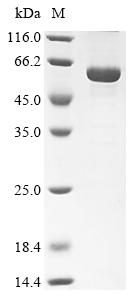Recombinant Bovine Retinal dehydrogenase 1 (ALDH1A1)
CAT:
399-CSB-EP001565BO-02
Size:
100 µg
Price:
Ask
- Availability: 24/48H Stock Items & 2 to 6 Weeks non Stock Items.
- Dry Ice Shipment: No




Recombinant Bovine Retinal dehydrogenase 1 (ALDH1A1)
- CAS Number: 9000-83-3
- Gene Name: ALDH1A1
- UniProt: P48644
- Expression Region: 2-501aa
- Organism: Bos taurus
- Target Sequence: SSSAMPDVPAPLTNLQFKYTKIFINNEWHSSVSGKKFPVFNPATEEKLCEVEEGDKEDVDKAVKAARQAFQIGSPWRTMDASERGRLLNKLADLIERDHLLLATMEAMNGGKLFSNAYLMDLGGCIKTLRYCAGWADKIQGRTIPMDGNFFTYTRSEPVGVCGQIIPWNFPLLMFLWKIGPALSCGNTVVVKPAEQTPLTALHMGSLIKEAGFPPGVVNIVPGYGPTAGAAISSHMDVDKVAFTGSTEVGKLIKEAAGKSNLKRVSLELGGKSPCIVFADADLDNAVEFAHQGVFYHQGQCCIAASRLFVEESIYDEFVRRSVERAKKYVLGNPLTPGVSQGPQIDKEQYEKILDLIESGKKEGAKLECGGGPWGNKGYFIQPTVFSDVTDDMRIAKEEIFGPVQQIMKFKSLDDVIKRANNTFYGLSAGIFTNDIDKAITVSSALQSGTVWVNCYSVVSAQCPFGGFKMSGNGRELGEYGFHEYTEVKTVTIKISQKNS
- Tag: N-terminal 10xHis-tagged and C-terminal Myc-tagged
- Source: E.coli
- Field of Research: Others
- Assay Type: In Stock Protein
- Relevance: Cytosolic dehydrogenase that catalyzes the irreversible oxidation of a wide range of aldehydes to their corresponding carboxylic acid. Functions downstream of retinol dehydrogenases and catalyzes the oxidation of retinaldehyde into retinoic acid, the second step in the oxidation of retinol/vitamin A into retinoic acid. This pathway is crucial to control the levels of retinol and retinoic acid, two important molecules which excess can be teratogenic and cytotoxic (Probable). Also oxidizes aldehydes resulting from lipid peroxidation like (E)-4-hydroxynon-2-enal/HNE, malonaldehyde and hexanal that form protein adducts and are highly cytotoxic. By participating for instance to the clearance of (E)-4-hydroxynon-2-enal/HNE in the lens epithelium prevents the formation of HNE-protein adducts and lens opacification. Functions also downstream of fructosamine-3-kinase in the fructosamine degradation pathway by catalyzing the oxidation of 3-deoxyglucosone, the carbohydrate product of fructosamine 3-phosphate decomposition, which is itself a potent glycating agent that may react with lysine and arginine side-chains of proteins. Has also an aminobutyraldehyde dehydrogenase activity and is probably part of an alternative pathway for the biosynthesis of GABA/4-aminobutanoate in midbrain, thereby playing a role in GABAergic synaptic transmission.
- Purity: Greater than 85% as determined by SDS-PAGE.
- Activity: Not Test
- Length: Full Length of Mature Protein
- Form: Liquid or Lyophilized powder
- Buffer: If the delivery form is liquid, the default storage buffer is Tris/PBS-based buffer, 5%-50% glycerol. If the delivery form is lyophilized powder, the buffer before lyophilization is Tris/PBS-based buffer, 6% Trehalose, pH 8.0.
- Reconstitution: We recommend that this vial be briefly centrifuged prior to opening to bring the contents to the bottom. Please reconstitute protein in deionized sterile water to a concentration of 0.1-1.0 mg/mL.We recommend to add 5-50% of glycerol (final concentration) and aliquot for long-term storage at -20℃/-80℃. Our default final concentration of glycerol is 50%. Customers could use it as reference.
- Molecular Weight: 62.1 kDa
- References & Citations: "Characterization of 954 bovine full-CDS cDNA sequences." Harhay G.P., Sonstegard T.S., Keele J.W., Heaton M.P., Clawson M.L., Snelling W.M., Wiedmann R.T., Van Tassell C.P., Smith T.P.L. BMC Genomics 6:166-166 (2005)
- Storage Conditions: The shelf life is related to many factors, storage state, buffer ingredients, storage temperature and the stability of the protein itself. Generally, the shelf life of liquid form is 6 months at -20℃/-80℃. The shelf life of lyophilized form is 12 months at -20℃/-80℃.
